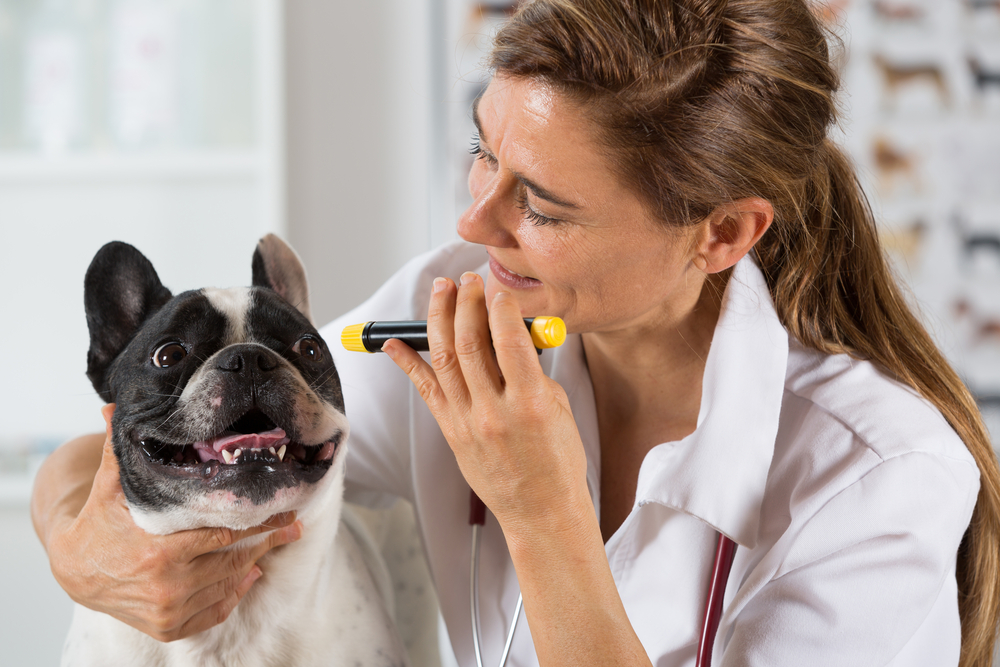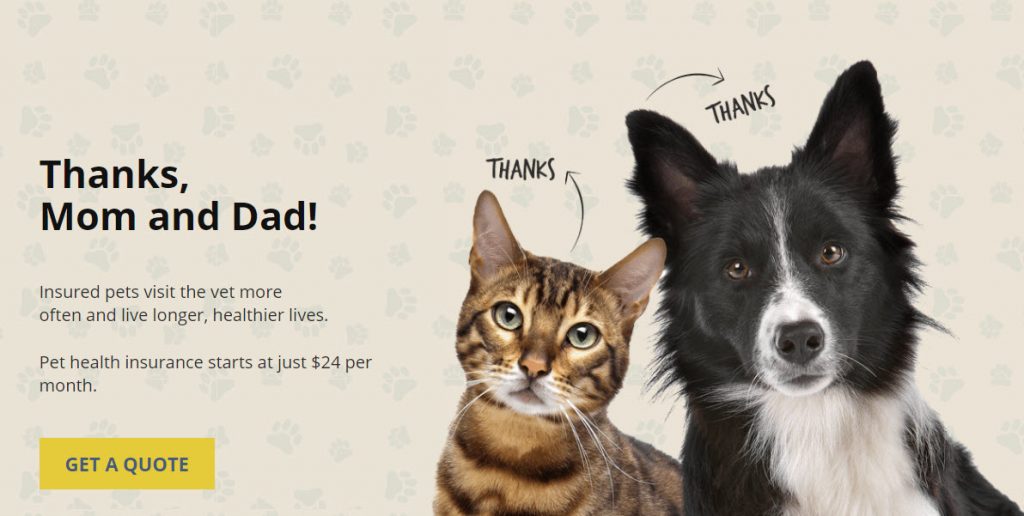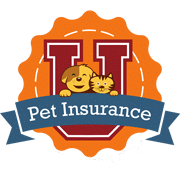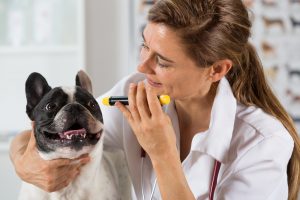Eye Problems in Dogs

Free Pet Insurance Comparison
Compare Quotes From Top Companies and Save
Secured with SHA-256 Encryption
Dr. Pippa Elliott BVMS, MRCVS
Veterinarian
Dr Pippa Elliott BVMS, MRCVS is a veterinarian with over 30 years of experience in companion animal practice. In 1987 she graduated from the University of Glasgow, with a degree in veterinary medicine and surgery. She works at Blythwood Vets and the People’s Dispensary for Sick Animals (PDSA). Pippa is an advocate of Fear-Free Practice, an animal addict, and a veterinary writer. She is also w...
Veterinarian
UPDATED: Feb 3, 2025
Pet Insurance U receives compensation from the third parties included on this site. This includes payment for clicks from our site to insurance providers’ sites and quote requests generated. Our rankings and reviews are not affected by payments from the insurance companies. The compensation we receive allows the site to be free and regularly updated. Our goal is to review every pet insurance provider, but not all companies are listed on the site.
And many of the companies we review do not pay us anything. We simply rate, compare and review their plan because we feel it will be valuable to you. Our reviews are guaranteed to be unbiased, professional and advertising compensation does not influence rankings.
We are a free online resource for anyone interested in learning more about pet insurance. Our goal is to be an objective, third-party resource for everything pet insurance related. We update our site regularly, and all content is reviewed by pet insurance experts.
UPDATED: Feb 3, 2025
Pet Insurance U receives compensation from the third parties included on this site. This includes payment for clicks from our site to insurance providers’ sites and quote requests generated. Our rankings and reviews are not affected by payments from the insurance companies. The compensation we receive allows the site to be free and regularly updated. Our goal is to review every pet insurance provider, but not all companies are listed on the site.
And many of the companies we review do not pay us anything. We simply rate, compare and review their plan because we feel it will be valuable to you. Our reviews are guaranteed to be unbiased, professional and advertising compensation does not influence rankings.
On This Page
There are many different eye problems that can plague dogs, many of which are congenital conditions that the dog is born with or even hereditary conditions that are developed later in life.
Other eye issues are just the normal progression of the aging process in our dogs, particularly issues like Cataracts and Glaucoma.
Need Pet Insurance?
FACT: Pet insurance pays up to 90% of vet bills when your pet is sick or injured!
Symptoms of Eye Problems in Dogs
Some of the more common symptoms of eye problems in dogs:
- Crusty gunk and discharge
- White or red eyelid linings
- Visible abnormalities, such as a third eyelid
- Tear-stained fur
- Change in eye color
- Cloudiness
- An eye that won’t open
- Different sized pupils
- Excessive tearing
Related: 10 Things You Must Know Before You Buy Pet Insurance
Enter your ZIP code below to view companies that have cheap pet insurance rates.
Secured with SHA-256 Encryption
Common Eye Problems in Dogs
The most common eye problems in dogs are the following:
1. Cataracts
Cataracts cause cloudy eyes in dogs making them murky, grey/blue and clouded. The eye’s natural transparency becomes more opaque as the disease progresses.
If the eye becomes totally opaque, blindness will occur.
Some of the causes of canine cataracts are the following:
-
Birth-defects
- Diabetes
- Eye injury
- Genetic inheritance
- Infection
- Nutritional disorders
- Old-age
- Radiation from cancer therapy
- Toxic cataracts caused by disease
Surgery is the most common and successful treatment of cataracts.
2. Cherry Eye
Cherry eye is a condition involving the gland of a third eyelid known as the nictitating membrane. This membrane slips forward which then produces a visible red mass in the inner corner of the dog’s eye.
Cherry eye is more common in puppies and can be caused by the weakness of the connective tissue behind the eye. It is known to be a hereditary condition.
Surgery is the best and most common treatment with a high success rate of 80%.
3. Coloboma
Coloboma is an eye disorder when a dog’s iris has a hole in it or is split.
Coloboma can be inherited and considered a congenital condition when there is an incomplete eye tissue development prior to birth.
Eye trauma and/or injuries can result in coloboma.
There is no corrective treatment for this condition and a dog will not have impaired vision but just sensitivity to sunlight or direct bright light.
Real Cost Savings from PetFirst Clients

Luna
PetFirst saved his parents
$6,712
A happy energetic Luna one morning couldn’t hold her food down. After months of multiple costly vet visits to specialists and an endoscopy, the problem was discovered and fixed. Luna put 22 pounds back on in no time and her parents were grateful for having PetFirst by their side to pay the bills.
4. Corneal Ulcers
A Corneal ulcer occurs when the deep layer of the dog’s cornea is lost or has been eroded.
The usual cause of a corneal ulcer is if a dog is injured or there is trauma to the dog’s eye. The condition can also be caused by disease, infection, paralysis of a nerve around the face or a tear deficiency.
The treatment, depending on the severity of the condition, usually includes pain medication for comfort and antibiotics to prevent infection.
Some less serious corneal ulcers can heal on their own, while the more serious ulcers that are deeper in the eye could require surgery.
5. Distichiasis
Distichiasis is a condition where there is an abnormal growth of eyelashes where they shouldn’t be growing. It can affect both the lower and upper eyelids, both eyes, or merely one eye.
Distichiasis can become problematic when the eyelashes protrude inward and therefore irritate the dog’s cornea.
One of the more minor, less invasive eye conditions, the prognosis is very positive.
The treatment for distichiasis usually includes the removal of the abnormal eyelashes, either manually or through electrolysis, cryotherapy or surgery.
6. Ectropion
Ectropion in dogs is a condition when the eyelids tend to droop or roll out. It can occur in either one or even both eyes and usually affects the lower eyelids.
This is a condition that is inherent in certain breeds and is considered a hereditary condition.
Ectropion will affect the conjunctival tissues that line the inner surface of the eyelids and will cover the entire eyeball. The result is dry eyes and conjunctivitis.
Ectropion is caused by nerve paralysis, injury to the cornea or eye and trauma.
In minor cases, the treatment is ointment on the eyelids or eye drops. In more severe cases, surgery may be required.
7. Entropion
Entropion is a congenital condition that occurs when the eyelid inverts or rolls inward.
The result is that the dog’s eyelashes will constantly scrape the eyelid which can cause damage to the eyeball.
The lower dog’s eyelid is more often affected when a dog has Entropion. Entropion is typically an inherited abnormality and certain breeds are pre-disposed to the condition.
The best and most successful treatment is eyelid surgery.
8. Glaucoma
Glaucoma is a condition where the fluid that fills the eyes is increased to the point that it causes pressure behind the eyes.
Glaucoma can be very painful because it damages the internal structure of the eyes and can eventually leading to blindness.
The treatment depends on the cause and severity of glaucoma.
The main goal is to restore normal eye pressure; this can be achieved by decreasing fluid production and/or increasing fluid drainage.
Pain management is also an important part of the treatment. If there is an underlying disease causing glaucoma, it should be treated as well.
9. Progressive Retinal Atrophy
Progressive retinal atrophy is when the cells of the retina start to lose their function which can lead to blindness or impaired visions.
A gene mutation is responsible for the condition which is why it’s important to test certain breeds while they are young.
Some of the causes include the abnormal development of the retina with age, the natural aging process, an adverse reaction to a specific drug, a disease like cancer that spread to the retina.
There is no cure for retinal atrophy.
Some supplements and diet can help strengthen the eyesight in dogs and therefore help to prevent progressive retinal atrophy from occurring.

Does Pet Insurance Cover Dog Eye Problems?
There are many different eye problems that could occur in your dogs and pet insurance will cover many, if not all, of these eye problems.
If your dog is born with one of these eye issues, then pet insurance might not cover this particular condition.
However, most of these congenital and hereditary eye issues won’t present themselves until later in life and therefore if you enroll your dog when he or she is young, the disease won’t be considered pre-existing and will be covered.
The cost of these eye issues can range anywhere from $200 to $7,500 for more serious conditions.
Plans like Healthy Paws and Embrace will cover up to 90% of the costs of any of these eye issues which enables you to get the best care for your dog.
Prevention Tips For Eye Problems In Dogs
The best prevention for any of these eye issues is to keep up with your annual vet visits to detect any illness that might occur.
If you have a certain breed of dog that is predisposed to any of these eye conditions, early testing is always a good, proactive idea.
To learn more about the other issues that can occur in your dog, our dog health problems glossary is a great place to start!
Other articles you may find helpful:
Is Exotic Pet Insurance Necessary?
The Best Pet Insurance By State
Fun Facts, Dog FAQ, And Unsolicited Dog Advice
5 Training Commands to Save Your Dog’s Life
The Ultimate Guide to Safe Foods for Dogs
We get it, your dog is like your child and when your puppy or dog has health problems it is scary. Luckily there is pet insurance companies that will help you pay for any veterinarian care they made need. Checkout the best puppy and dog pet insurance companies and learn about common puppy health issues and ailments in older pets.
Common Health Problems:
Chronic Active Hepatitis in Dogs
Cruciate Ligament Tear in Dogs
Degenerative Myelopathy | Spinal Cord Disease In Dogs
Dementia in Dogs | Canine Cognitive Dysfunction
Dog Comedones (Schnauzer Bumps)
Dog Diarrhea: What Can You Do To Help?
Gallbladder Obstruction in Dogs
Heart Murmurs In Dogs | How To Identify Them
Intervertebral Disc Disease In Dogs
Nasal Solar Dermatitis In Dogs
Progressive Retinal Atrophy In Dogs
The Dog Flu – Symptoms & Treatment for Canine Influenza
Enter your ZIP code below to view companies that have cheap pet insurance rates.
Secured with SHA-256 Encryption
Frequently Asked Questions
What are some common symptoms of eye problems in dogs?
Some common symptoms of eye problems in dogs include redness, cloudiness, discharge, excessive tearing, squinting, pawing at the eyes, and changes in the appearance of the eyes.
What are the most common eye problems in dogs?
The most common eye problems in dogs include cataracts, cherry eye, coloboma, corneal ulcers, distichiasis, ectropion, entropion, glaucoma, and progressive retinal atrophy.
Does pet insurance cover dog eye problems?
Yes, many pet insurance plans cover a range of eye problems in dogs. However, if your dog is born with a pre-existing eye condition, it may not be covered. Enrolling your dog in insurance when they are young can help ensure coverage for future conditions.
What is the cost of treating dog eye problems?
The cost of treating dog eye problems can vary widely, ranging from $200 to $7,500 for more serious conditions. Pet insurance plans like Healthy Paws and Embrace can cover up to 90% of these costs.
Are congenital and hereditary eye issues covered by pet insurance?
Most congenital and hereditary eye issues won’t present themselves until later in a dog’s life. If you enroll your dog in insurance when they are young, these conditions won’t be considered pre-existing and are likely to be covered.
Are there prevention tips for dog eye problems?
Regular annual vet visits are crucial for early detection of any eye issues. If your dog belongs to a breed predisposed to certain eye conditions, early testing is recommended. Additionally, maintaining overall good health can contribute to eye health.
Can supplements and diet help prevent progressive retinal atrophy in dogs?
While there is no cure for progressive retinal atrophy, some supplements and a balanced diet can help strengthen eyesight in dogs and potentially prevent the onset of this condition.
Who is the author of the provided content?
The content is written by Melanie Musson, a published insurance expert, and reviewed by Dr. Pippa Elliott BVMS, MRCVS, a veterinarian.
Is the information on petinsuranceu.com unbiased?
Yes, the information on petinsuranceu.com is guaranteed to be unbiased. The site receives compensation from third parties, but it does not influence rankings or reviews. The goal is to be an objective, third-party resource for pet insurance information.
How can I contact petinsuranceu.com for more information?
You can visit the petinsuranceu.com website for more information, and there may be contact details available on the site for any specific inquiries or assistance.
Enter your ZIP code below to view companies that have cheap pet insurance rates.
Secured with SHA-256 Encryption
Dr. Pippa Elliott BVMS, MRCVS
Veterinarian
Dr Pippa Elliott BVMS, MRCVS is a veterinarian with over 30 years of experience in companion animal practice. In 1987 she graduated from the University of Glasgow, with a degree in veterinary medicine and surgery. She works at Blythwood Vets and the People’s Dispensary for Sick Animals (PDSA). Pippa is an advocate of Fear-Free Practice, an animal addict, and a veterinary writer. She is also w...
Veterinarian
We are a free online resource for anyone interested in learning more about pet insurance. Our goal is to be an objective, third-party resource for everything pet insurance related. We update our site regularly, and all content is reviewed by pet insurance experts.

